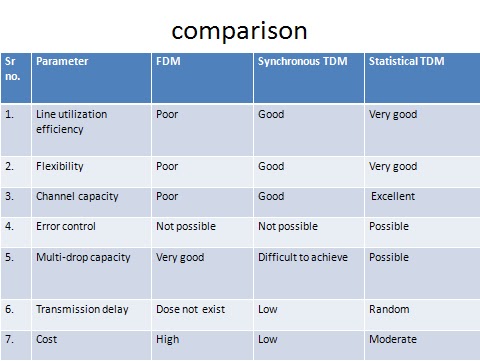Difference in FDM and synchronus TDM and statistical TDM:
In the realm of telecommunications and data transmission, the efficient utilization of bandwidth and the assurance of reliable data transfer stand as paramount objectives. To meet these goals, a variety of techniques such as Frequency Division Multiplexing (FDM), Synchronous Time Division Multiplexing (TDM), and Statistical Time Division Multiplexing (TDM) are utilized. It is imperative to grasp the unique characteristics, advantages, and applications of each method for effective implementation.
Frequency Division Multiplexing (FDM):
FDM is a conventional method facilitating the simultaneous transmission of multiple signals over a shared medium, such as cables or airwaves. Its principle is straightforward: dividing the available bandwidth into distinct non-overlapping frequency bands and assigning each band to a different signal. This approach allows for concurrent transmission without signal interference.
Strengths of FDM include its simplicity and ease of implementation, enabling multiple users to share a channel without intricate synchronization requirements. Additionally, it ensures consistent performance by allocating a fixed bandwidth to each signal. However, FDM may suffer from limitations in spectral efficiency due to dedicated frequency bands for each signal, potentially leading to unused bandwidth and requiring meticulous frequency planning to avoid interference from adjacent channels.
FDM is a conventional method facilitating the simultaneous transmission of multiple signals over a shared medium, such as cables or airwaves. Its principle is straightforward: dividing the available bandwidth into distinct non-overlapping frequency bands and assigning each band to a different signal. This approach allows for concurrent transmission without signal interference.
Strengths of FDM include its simplicity and ease of implementation, enabling multiple users to share a channel without intricate synchronization requirements. Additionally, it ensures consistent performance by allocating a fixed bandwidth to each signal. However, FDM may suffer from limitations in spectral efficiency due to dedicated frequency bands for each signal, potentially leading to unused bandwidth and requiring meticulous frequency planning to avoid interference from adjacent channels.
Synchronous Time Division Multiplexing (TDM):
Synchronous TDM allocates fixed-duration time slots within the available bandwidth, assigning each slot to a different signal. Unlike FDM, which partitions based on frequency, TDM operates on a time-based division, sequentially transmitting signals within their designated slots.
An advantage of synchronous TDM is its efficient bandwidth utilization, achieved through dynamic slot allocation that adapts to varying traffic patterns, minimizing unused bandwidth. Additionally, synchronized transmission helps mitigate signal interference between channels. Nonetheless, scalability can be challenging for synchronous TDM as managing synchronization overhead becomes more complex with increased users. Moreover, accommodating variable-bit-rate data streams may pose difficulties.
Synchronous TDM allocates fixed-duration time slots within the available bandwidth, assigning each slot to a different signal. Unlike FDM, which partitions based on frequency, TDM operates on a time-based division, sequentially transmitting signals within their designated slots.
An advantage of synchronous TDM is its efficient bandwidth utilization, achieved through dynamic slot allocation that adapts to varying traffic patterns, minimizing unused bandwidth. Additionally, synchronized transmission helps mitigate signal interference between channels. Nonetheless, scalability can be challenging for synchronous TDM as managing synchronization overhead becomes more complex with increased users. Moreover, accommodating variable-bit-rate data streams may pose difficulties.
Statistical Time Division Multiplexing (TDM):
Statistical TDM offers flexibility by dynamically adjusting time slot durations based on traffic characteristics. Unlike synchronous TDM's fixed-duration slots, statistical TDM optimizes slot duration according to data traffic volume.
Its primary advantage lies in adaptability to fluctuating traffic conditions, efficiently utilizing available bandwidth even in scenarios with variable data rates. This makes it well-suited for applications like packet-switched networks. However, statistical TDM introduces complexity compared to synchronous TDM. Sophisticated scheduling algorithms are necessary to allocate bandwidth effectively, and additional signaling and control mechanisms are required for dynamic slot assignments, leading to increased overhead.
Statistical TDM offers flexibility by dynamically adjusting time slot durations based on traffic characteristics. Unlike synchronous TDM's fixed-duration slots, statistical TDM optimizes slot duration according to data traffic volume.
Its primary advantage lies in adaptability to fluctuating traffic conditions, efficiently utilizing available bandwidth even in scenarios with variable data rates. This makes it well-suited for applications like packet-switched networks. However, statistical TDM introduces complexity compared to synchronous TDM. Sophisticated scheduling algorithms are necessary to allocate bandwidth effectively, and additional signaling and control mechanisms are required for dynamic slot assignments, leading to increased overhead.
Conclusion:
In summary, FDM, synchronous TDM, and statistical TDM represent distinct methods for multiplexing signals over a shared communication channel. While FDM divides bandwidth based on frequency, synchronous TDM does so based on time, and statistical TDM dynamically adjusts slot durations.
Each method has its advantages and limitations, catering to different applications and scenarios. FDM offers simplicity but may lack spectral efficiency. Synchronous TDM optimizes bandwidth utilization but faces scalability challenges. Statistical TDM provides adaptability but introduces complexity.
Ultimately, the choice between these techniques depends on factors such as application nature, desired flexibility, and available resources. A comprehensive understanding of their disparities empowers network engineers to design and implement communication systems effectively.
In summary, FDM, synchronous TDM, and statistical TDM represent distinct methods for multiplexing signals over a shared communication channel. While FDM divides bandwidth based on frequency, synchronous TDM does so based on time, and statistical TDM dynamically adjusts slot durations.
Each method has its advantages and limitations, catering to different applications and scenarios. FDM offers simplicity but may lack spectral efficiency. Synchronous TDM optimizes bandwidth utilization but faces scalability challenges. Statistical TDM provides adaptability but introduces complexity.
Ultimately, the choice between these techniques depends on factors such as application nature, desired flexibility, and available resources. A comprehensive understanding of their disparities empowers network engineers to design and implement communication systems effectively.
